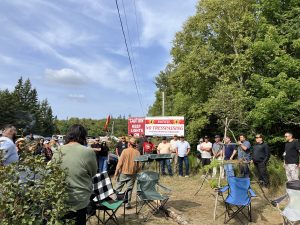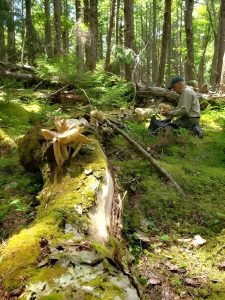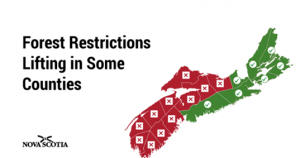Updates
– Oct 9, 2025: Community members want land protected amid concerns over clearcutting
Michael Gorman · CBC News “Mike Lancaster is growing frustrated. For 10 years, the executive director of the St. Margarets Bay Stewardship Association has been part of a group of people working to get provincial protection for the proposed Ingram River wilderness area, about 11,000 hectares of Crown land that once belonged to Bowater. But as people continue to wait to see if the government will act, Lancaster says part of the proposed area is seeing applications for high-production forestry activity, such as clearcutting.Lancaster said the proposed wilderness area would include “one of the most, if not the most, ecologically valuable parts of Nova Scotia.” Within the 11,000 hectares is the oldest-known forest in the Maritimes, core habitat essential to the survival of the Mainland Moose, 16 species at risk that have been identified, and an additional 72 considered species of conservation concern. “How can you not want to protect an area that has the literal oldest forest in the Maritimes,” said Lancaster. “It’s a failure of government and public policy to not make this happen at this point.” Neither Natural Resources Minister Tory Rushton nor Environment Minister Tim Halman would agree to an interview for this story….In a statement, a spokesperson for the Natural Resources Department said about 4,000 hectares of land in the Ingram River area has been protected as part of the Island Lake Wilderness Area, where no forestry activity is permitted. The statement goes on to say that harvesting that is happening in the Ingram River area is happening in places that are “not pristine wilderness.”But Lancaster said the province is missing out on the economic development potential of activities such as ecotourism and guiding that would come through the creation of a new wilderness area. He said the group’s proposal, which is supported by more than 50 citizen and business groups, would allow for ecological forestry activity — but not clearcutting — on about 70 per cent of the area that would make up the Ingram River wilderness area…”
– Sep 5, 2025: Province doubles area designated for proposed high-production forestry in Ingram River Wilderness Area
Madiha Hughees in the Hfx Examiner, Intro by Philip Muscovitvh in Morning File “The area targeted for high-production forestry (HPF) within the proposed Ingram River Wilderness Area (IRWA) has more than doubled, putting at risk the oldest documented forest in the Maritimes, a core mainland moose habitat, and several at-risk species. This means 346 hectares (854.72 acres) of the St. Margaret’s Bay watershed would be clearcut, with about 164 hectares within the proposed Ingram River Wilderness Area. Mughees speaks with forester Mike Lancaster, executive director of the St. Margaret’s Bay Stewardship Association…Lancaster and his organization have worked hard to protect that area. Part of the area slated for clearcutting is a parcel that he and the Stewardship Association have spent considerable time and money restoring.”
– Aug 15, 2025: Concerned citizens attend full house meeting in Tantallon about proposed clearcutting of Ingram River Wilderness Area
Madiha Mughees in the Hfx Examiner. Intro in Morning File “About 100 people packed a Tantallon Public Library meeting space on Wednesday evening for a public awareness event about the importance of the proposed Ingram River Wilderness Area, which has been designated for high-production forestry. Organizers argued that the area provides significant economic and ecological value and should be conserved. “Over 195.65 hectares, or 483.26 acres, of High Production Forestry has been proposed for the St. Margaret’s Bay watershed,” noted a Facebook post announcing the event.”
– July 30, 2025: Letter from Nina Newington/SOOF to DNR Minister Rushton “concerning the Department of Natural Resources (DNR) plans to clearcut in the proposed Ingram River Wilderness Area as well as in the Beals Brook, Tobeatic-Tidney Extension andChain Lakes Wilderness Areas.
– July 22, 2025: ‘All is not well here in the forests of Nova Scotia’: An open letter to the Minister of Environment and Climate Change by Bev Wigney in the Halifax Examiner.
– July 20, 2025: NatureNS: Community Nominated Protected Areas Need Your Help & How you can help
-July 17, 2025: The EAC’s Statement on the Prioritization of Clearcutting over Conservation in the Proposed Ingram River Wilderness Area
————————
Original Post
A Forest Alert issued by the Healthy Forest Coalition Jul 14, 2025:
 Just over 195.65 ha, or 483.26 acres, of High Production Forestry has been proposed for the St. Margaret’s Bay watershed. This equates to over 366 football fields. 77.53 ha, or 191.5 acres, of those harvests have been proposed within the proposed Ingram River Wilderness Area (IRWA) under three separate polygons: Continue reading →
Just over 195.65 ha, or 483.26 acres, of High Production Forestry has been proposed for the St. Margaret’s Bay watershed. This equates to over 366 football fields. 77.53 ha, or 191.5 acres, of those harvests have been proposed within the proposed Ingram River Wilderness Area (IRWA) under three separate polygons: Continue reading →









